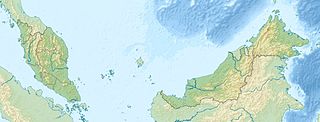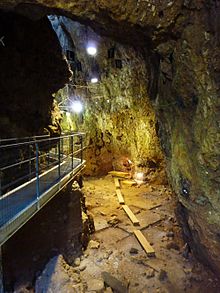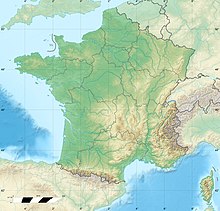The possible shelter
Occupation layers of the cave in use during marine isotopic stage 6 (186,000 to 127,000 years ago) were excavated during the 1970s and may demonstrate construction abilities and other organisational skills by the inhabitants at the time.
Close to the mouth of the cave and along one wall were found Acheulean stone tools along with fragments of animal bone surrounding two circular charcoal concentrations which likely served as hearths. This occupation area measures 11 by 3.5 m (36 by 11 ft) and was delimited by the cave wall on three sides and on the fourth by a sinuous line of large stones. It is these which have been interpreted as having served as packing stones that could have been used to support the poles of an animal skin tent pitched against the cave wall. No evidence of the organic tent poles or tent itself would have survived but stone tool flakes and animal bone appear to spill outwards from between the stones at two points which may represent entrances to the conjectured shelter.
Finds of tiny sea shells surrounding the hearths may represent seaweed brought into the cave to serve as bedding. This may indicate specialised activity areas within the settlement with an inner domestic area and an outer one which would have been covered by the tent but presumably used for another purpose.
It is by no means certain that the stones were brought into the cave and placed by people however and natural processes or a reason for their placement not involving a structure may explain their presence. The limited evidence from nearby sites where similar stone tools and other cultural material have been found close to concentrations of natural rocks is less compelling than at Le Lazaret. Examples of these similar sites include La Baume Bonne (in Quinson, Alpes-de-Haute-Provence) and Orgnac. The evidence for housing in the archaeological record prior to the arrival of modern humans 50,000 years ago is slim, although any flimsy structure built prior to this time is unlikely to leave unmistakable archaeological traces after so long.

Acheulean, from the French acheuléen after the type site of Saint-Acheul, is an archaeological industry of stone tool manufacture characterized by distinctive oval and pear-shaped "hand-axes" associated with Homo erectus and derived species such as Homo heidelbergensis.

Monte Verde is an archaeological site in southern Chile, located near Puerto Montt, Southern Chile, which has been dated to as early as 18,500 cal BP. Previously, the widely accepted date for early occupation at Monte Verde was ~14,500 years cal BP. This dating added to the evidence showing that the human settlement of the Americas pre-dates the Clovis culture by roughly 1000 years. This contradicts the previously accepted "Clovis first" model which holds that settlement of the Americas began after 13,500 cal BP. The Monte Verde findings were initially dismissed by most of the scientific community, but the evidence then became more accepted in archaeological circles.

Blombos Cave is an archaeological site located in Blombos Private Nature Reserve, about 300 km east of Cape Town on the Southern Cape coastline, South Africa. The cave contains Middle Stone Age (MSA) deposits currently dated at between c. 100,000 and 70,000 years Before Present (BP), and a Late Stone Age sequence dated at between 2000 and 300 years BP. The cave site was first excavated in 1991 and field work has been conducted there on a regular basis since 1997, and is ongoing.

The Tsodilo Hills are a UNESCO World Heritage Site (WHS), consisting of rock art, rock shelters, depressions, and caves. It gained its WHS listing in 2001 because of its unique religious and spiritual significance to local peoples, as well as its unique record of human settlement over many millennia. UNESCO estimates there are over 4500 rock paintings at the site. The site consists of a few main hills known as the Child Hill, Female Hill, and Male Hill.

Lenggong is a town, a mukim and a parliamentary constituency in Hulu Perak District, Perak, Malaysia. The Lenggong valley in Hulu Perak is one of Peninsular Malaysia's most important areas for archaeology, as excavations have revealed many traces of Malaysia's prehistory. It is the site of the oldest known place of human activity in the Peninsula. Today it is still a rural area, with small kampongs surrounded by green vegetation and limestone hills. Lenggong can be likened to an open-air museum, and is home to legends, skeletons, cave drawings and precious finds such as jewellery, pottery, weapons and stone tools. Many of the caves in the Lenggong area have revealed evidence of ancient humans having lived and hunted in this area. The Lenggong Valley was listed by UNESCO as a World Heritage site on 30 June 2012.

Lussac-les-Châteaux is a commune in the Vienne department in the Nouvelle-Aquitaine region in western France.

Makapansgat is an archaeological location within the Makapansgat and Zwartkrans Valleys, northeast of Mokopane in Limpopo province, South Africa. It is an important palaeontological site, with the local limeworks containing Australopithecus-bearing deposits dating to between 3.0 and 2.6 million years BP. The whole Makapan Valley has been declared a South African Heritage Site. Makapansgat belongs to the Cradle of Humankind.

Divje Babe is a Karst cave and archaeological park overlooking the Idrijca River in Slovenia. It is noted for its Paleolithic remains, including the worked bone of cave bear known as the Divje Babe Flute, which has been interpreted as a Neanderthal musical instrument.

Cueva Fell is a natural cave and archaeological site in southern Patagonia. Cueva Fell is in proximity to the Pali Aike Crater, another significant archaeological site. Cueva Fell combined with the nearby Pali Aike site have been submitted to UNESCO as a possible World Heritage Site.

Sibudu Cave is a rock shelter in a sandstone cliff in northern KwaZulu-Natal, South Africa. It is an important Middle Stone Age site occupied, with some gaps, from 77,000 years ago to 38,000 years ago.
Howiesons Poort is a lithic technology cultural period in the Middle Stone Age in Africa named after the Howieson's Poort Shelter archeological site near Grahamstown in South Africa. It seems to have lasted around 5,000 years between roughly 65,800 BP and 59,500 BP.

Qesem cave is a Lower Paleolithic archeological site near the city of Kafr Qasim in Israel. Early humans were occupying the site by 400,000 until c. 200,000 years ago.

Diepkloof Rock Shelter is a rock shelter in Western Cape, South Africa in which has been found some of the earliest evidence of the human use of symbols, in the form of patterns engraved upon ostrich eggshell water containers. These date around 60,000 years ago.
Broken Mammoth, Alaska is an archeological site located in the Tanana River Valley, Alaska, in the United States. The site was occupied approximately 11,000 B.P. to 12,000 B.P. making this one of the oldest known sites in Alaska. Charles E. Holmes discovered the site in 1989 and investigation of the site began in 1990 and excavations are ongoing to this day.

Aboriginal sites of Victoria form an important record of human occupation for probably more than 40,000 years. They may be identified from archaeological remains, historical and ethnographic information or continuing oral traditions and encompass places where rituals and ceremonies were performed, occupation sites where people ate, slept and carried out their day to day chores, and ephemeral evidence of people passing through the landscape, such as a discarded axe head or isolated artefact.

New Guinea II is a limestone cave and rockshelter on the Snowy River at the end of New Guinea Track, near Buchan, Victoria. The cave was within the country of the Krowathunkooloong clan of the Gunaikurnai nation. The deep cave system has an overhanging cliff that creates a rock shelter at the entrance facing the river. Excavations in the 1980s carried out by archaeologist Paul Ossa and a team from LaTrobe University found stone artefacts, and other signs of occupation that were dated to almost 20,000 BP.

Cloggs Cave is a limestone cave and rockshelter with significant Aboriginal archaeological deposits, located on a cliff along the Snowy River gorge near the town of Buchan, Victoria.
Humanity has used animal hides since the Paleolithic, for clothing as well as mobile shelters such as tipis and wigwams, and household items. Since ancient times, hides have also been used as a writing medium, in the form of parchment.

Melkhoutboom Cave is an archaeological site dating to the Later Stone Age, located in the Zuurberg Mountains, Cape Folded Mountain Belt, Sarah Baartman District Municipality in the Eastern Cape Province of South Africa.

Panga ya Saidi is an archaeological cave site located in Kilifi County, southeastern Kenya, about 15 km from the Indian Ocean in the Dzitsoni limestone hills. The cave site has rich archaeological deposits dating to the Middle Stone Age, Later Stone Age, and Iron Age. Excavated deposits preserve an unusually long record of human activities, from around 78,000 years ago until around 400 years ago, a chronology supported by radiocarbon dating and optically stimulated luminescence dating. This sequence puts Panga ya Saidi alongside other key sites such as Enkapune ya Muto, Mumba Rockshelter, and Nasera Rockshelter that are important for understanding the Late Pleistocene and the Middle to Later Stone Age transition in eastern Africa.


















